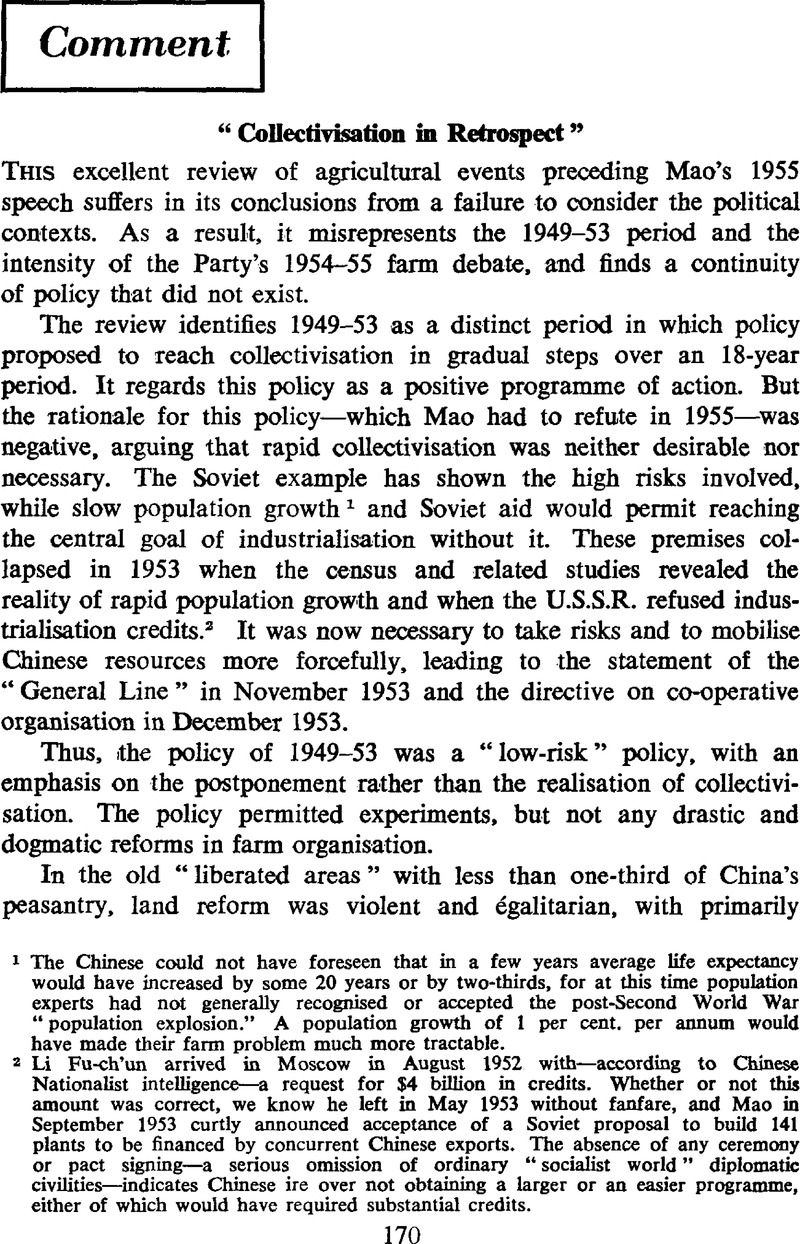No CrossRef data available.
Article contents
“Collectivisation in Retrospect”
Published online by Cambridge University Press: 17 February 2009
Abstract

- Type
- Comment
- Information
- Copyright
- Copyright © The China Quarterly 1967
References
1 The Chinese could not have foreseen that in a few years average life expectancy would have increased by some 20 years or by two-thirds, for at this time population experts had not generally recognised or accepted the post-Second World War “population explosion.” A population growth of 1 per cent, per annum would have made their farm problem much more tractable.
2 Li Fu-ch'un arrived in Moscow in August 1952 with—according to Chinese Nationalist intelligence—a request for $4 billion in credits. Whether or not this amount was correct, we know he left in May 1953 without fanfare, and Mao in September 1953 curtly announced acceptance of a Soviet proposal to build 141 plants to be financed by concurrent Chinese exports. The absence of any ceremony or pact signing—a serious omission of ordinary “ socialist world” diplomatic civilities—indicates Chinese ire over not obtaining a larger or an easier programme, either of which would have required substantial credits.
3 Co-operatives could only be justified in terms of their long-run contribution to output, as , Mao himself stated in his 02 7, 1957 speech on “Contradictions “: “How long will it take to consolidate the co-operatives and end these arguments about their not having any superior qualities? Judging from the actual experience of many co-operatives, this will probably take five years or a little longer.…”Google Scholar
4 T'ao Chu, in his decennial article in Red Flag, No. 8, 07 31, 1965,Google ScholarPubMed identifies a “rightist” and “leftist” opposition. Teng Tze-hui, director of the Party's Rural Work Department, confessed he was one of the rightist leaders, while Ch'en Yun and Li Fu-ch'un, by their remarks, can be identified as leftist leaders. According to T'ao, “rightists” advocated “the ‘four great freedoms’ of hiring labour, of issuing private loans, of trading, and of buying, selling, and renting out land in the rural areas to guarantee the private ownership of property.” They argued that this step would stabilise the rural areas and advance production, and forgot that it would “cause China's revolution to halt at the democratic stage.” The “leftists” on the other hand stressed “that the urban work is the centre,… forcing the peasants into the fold of the bourgeoisie.”
5 Mao Tse-tung, “On the Question of Agricultural Cooperation”: “ [These comrades] fail to grasp the essential, main aspects and instead exaggerate non-essential, minor aspects.”
6 Ibid. “We must believe in the masses; we must believe in our Party: these are two cardinal principles. If we doubt these principles, we can do nothing.”
7 Yang, C. K., “A Chinese Village in Early Communist Transition,” 1959Google Scholar , describes a deliberate use of feudal terms to impress upon the peasant his obligations in return for the land he was “given” but of which he could not dispose.




